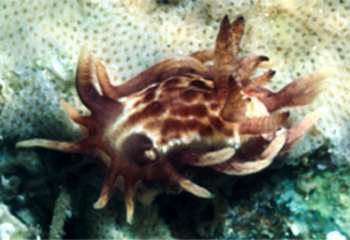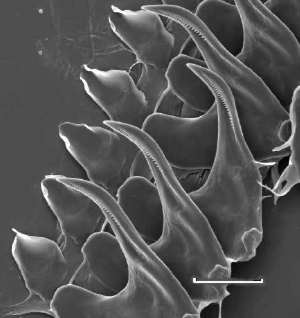

Okenia angelica
Gosliner and Bertsch, 2004
Order: NUDIBRANCHIA
Suborder: DORIDINA
Superfamily: ANADORIDOIDEA
Family: Goniodorididae
DISTRIBUTION
Known only from Bahía de los Ángeles, Baja California to the Bahía de Banderas region near Puerta Vallarta, Jalisco, México
PHOTO
Upper: Animal from Punta Gringa, Bahía de los Ángeles, Baja California, México. Photo: T. M. Gosliner. Lower: SEM of radula showing teeth from left side. Scale = 40 µm. [Photos from Gosliner & Bertsch, 2004 with permission].
The body is moderately wide and ovoid and relatively high in lateral profile with a distinct, well-developed, mantle border. The body is a deep purplish brown with an extensive reticulate pattern of opaque white on the mantle and dorsal part of posterior foot. The brown pigmentation often diffuses in to the white regions to give them a light orange brown, almost rusty, appearance. The rhinophores and lateral mantle papillae are translucent with a dusting of purple-brown pigment in the basal half and some opaque white dusting in the upper half. The gills are similar in colour to the papillae but have dark brown tips. Within the brown parts of the dorsal colour pattern are many small rounded tubercles. There are seven to nine elongate and slightly curved lateral papillae along each side of the mantle edge. The posterior pair of papillae on either side share a common base. There are no mid-dorsal mantle papillae, but two of the rounded tubercles are situated in the midline. There are no papillae on the posterior part of the foot. The living animals are between 10-20 mm in length.
The authors report that it is found on small stones in 1-2 meters of water and 'appears to be associated with bryozoans'
- Gosliner, T. M. & Bertsch, H. (2004) Systematics of Okenia from the Pacific Coast of North America (Nudibranchia: Goniodorididae) with descriptions of three new species. Proceedings of the California Academy of Sciences, 55: 412-428, figs. 1-11.
Rudman, W.B., 2004 (December 21) Okenia angelica Gosliner and Bertsch, 2004. [In] Sea Slug Forum. Australian Museum, Sydney. Available from http://www.seaslugforum.net/factsheet/okenange
